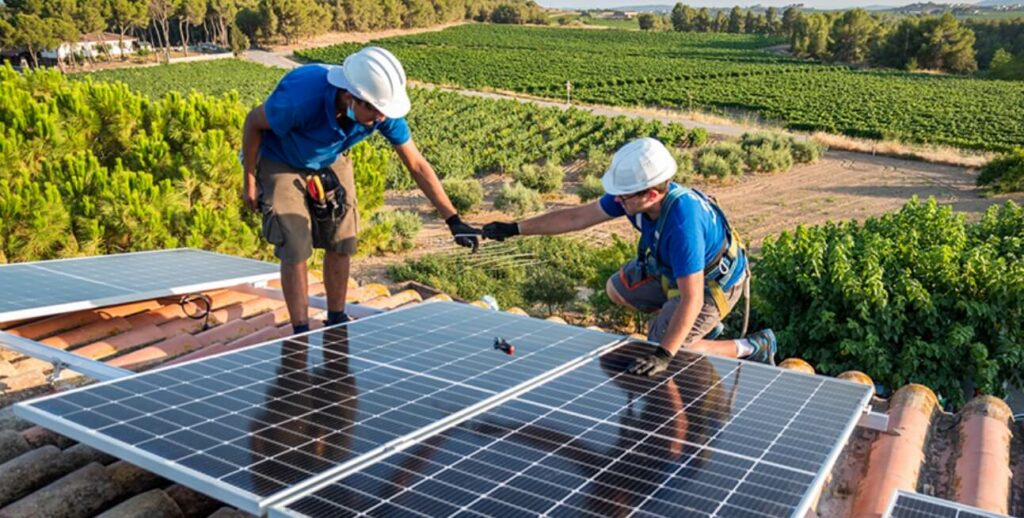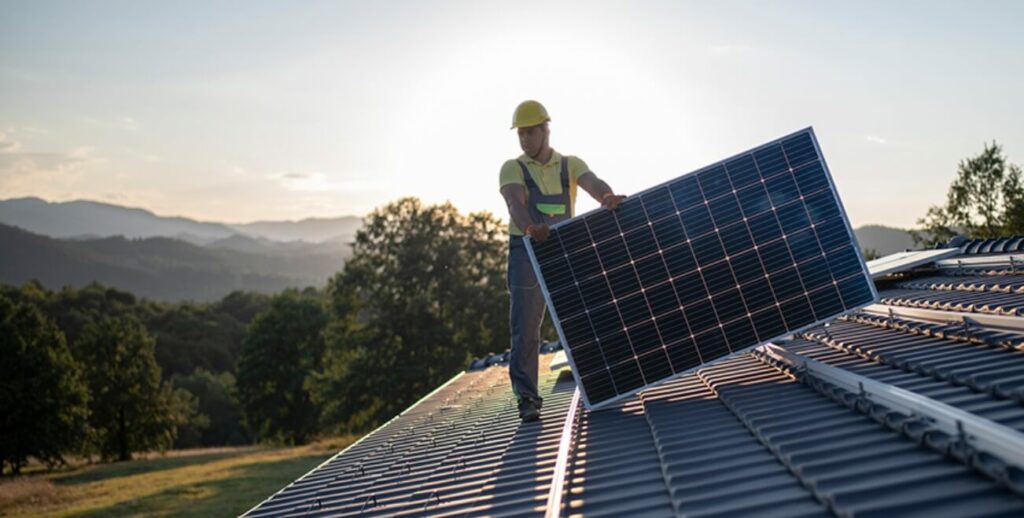An off-grid solar power plant, also known as a stand-alone solar power system, operates independently of the electrical grid. It is designed to generate and store electricity for use in locations without access to the grid or for users who prefer energy independence. Off-grid systems are commonly used in remote areas, cabins, boats, and for emergency backup power.
Components of an Off-Grid Solar Power Plant

- Solar Panels (Photovoltaic Modules):
- Convert sunlight into direct current (DC) electricity.
- Similar to on-grid systems, they come in various types such as monocrystalline, polycrystalline, and thin-film.
- Charge Controller:
- Regulates the voltage and current coming from the solar panels to the battery.
- Prevents overcharging and protects the battery from damage.
- Types include PWM (Pulse Width Modulation) and MPPT (Maximum Power Point Tracking).
- Battery Bank:
- Stores the DC electricity generated by the solar panels for use when sunlight is not available (e.g., at night or during cloudy days).
- Types include lead-acid batteries (flooded, AGM, gel) and lithium-ion batteries.
- Inverter:
- Converts the DC electricity stored in the batteries into alternating current (AC) electricity for use with standard household appliances.
- Types include pure sine wave and modified sine wave inverters.
- Mounting Structure:
- Provides support and optimal tilt for solar panels to maximize sunlight exposure.
- Can be ground-mounted or roof-mounted depending on the installation site.
- Backup Generator (Optional):
- Provides additional power during extended periods of low sunlight or high energy demand.
- Typically powered by diesel, gasoline, or propane.
How It Works
- Solar Panels Generate DC Electricity:
- Solar panels absorb sunlight and convert it into DC electricity.
- Charge Controller Manages Energy Flow:
- The charge controller regulates the flow of electricity from the solar panels to the battery bank, ensuring efficient and safe charging.
- Battery Bank Stores Energy:
- The battery bank stores the DC electricity generated by the solar panels for later use.
- The stored energy is crucial for powering electrical loads during periods without sunlight.
- Inverter Converts DC to AC:
- The inverter converts the DC electricity stored in the batteries into AC electricity, which is used to power household appliances and other electrical loads.
- Energy Consumption and Management:
- Electrical loads draw power from the battery bank via the inverter.
- The system may include monitoring and control mechanisms to optimize energy use and manage battery health.
Advantages of Off-Grid Solar Power Plants
- Energy Independence:
- Provides complete autonomy from the electrical grid.
- Ideal for remote locations and areas with unreliable or unavailable grid connections.
- Environmental Benefits:
- Reduces reliance on fossil fuels.
- Promotes renewable energy use and reduces carbon footprint.
- Reliability and Resilience:
- Ensures a continuous power supply even during grid outages.
- Suitable for critical applications and emergency backup.
Considerations
- Initial Investment:
- Higher upfront costs due to the need for batteries and other additional components.
- Financial incentives and rebates can help offset initial costs.
- System Sizing and Design:
- Requires careful sizing and design to meet energy needs and ensure adequate storage capacity.
- Oversizing can lead to unnecessary costs, while undersizing can result in insufficient power supply.
- Maintenance:
- Batteries require regular maintenance and eventual replacement.
- System components should be monitored and maintained to ensure optimal performance.
- Energy Management:
- Users need to be mindful of their energy consumption, especially during periods of low sunlight.
- Implementing energy-efficient appliances and practices can help extend battery life and system performance.
Steps to Implement an Off-Grid Solar Power Plant
- Site Assessment:
- Evaluate the site for solar potential, shading, and space availability.
- Energy Needs Analysis:
- Assess the energy consumption patterns and requirements.
- Determine the necessary capacity of the solar panels, battery bank, and inverter.
- System Design:
- Design the system based on energy needs, budget, and site conditions.
- Select appropriate components (panels, charge controller, batteries, inverter).
- Permitting and Approvals:
- Obtain necessary permits and approvals from local authorities, if required.
- Installation:
- Install solar panels, charge controller, batteries, inverter, and other components.
- Ensure proper wiring, grounding, and safety measures.
- Commissioning and Monitoring:
- Test and commission the system to ensure proper operation.
- Implement monitoring systems to track performance and maintenance needs.
By investing in an off-grid solar power plant, individuals and organizations can achieve energy independence and contribute to a more sustainable and resilient energy future.

Custom Listing Stlyes
- Satisfaction Value For Money Solution
- Business Accounting Management
- Inventory Management Tracking System
- The world as it is heavily dependent
- Reliability and performance
Dolore magna aliqua. Ut enim ad minim veniam, quis nostrud exercitation ullamco labip exeaco oris nisi ut aliquip ex ea commodo consequat. Duis aute irure dolor in reprehenderit in volupta te velit esse cillum dolore eu fugiat nulla pariatur. Excepteur sint occaecat cupidatat non proi dent, sunt in culpa qui officia deserunt mollit anim id est laborums nisi ut aliquip ex ea commo si ut aliquip ex ea commodo consequatdo.
reprehenderit in voluptate velit esse cillum dolore eu fugiat nulla pariatur. Excepteur sint occ aecat cupidatat non proident, sunt in culpa qui officia deserunt mollit anim id est laborums nisi ut aliquip ex ea commodo.
oris nisi ut aliquip ex ea commodo consequat. Duis aute irure dolor in reprehenderit in volupta te velit esse cillum dolore eu fugiat nulla pariatur. Excepteur sint occaecat cupidatat non proi dent, sunt in culpa qui officia deserunt mollit anim id est laborums nisi ut aliquip ex ea commo si ut aliquip ex ea commodo consequatdo.
Solar Renewables
Dolore magna aliqua. Ut enim ad minim veniam, quis nostrud exercitation ullamco labip exeaco oris nisi ut aliquip ex ea commodo consequat. Duis aute irure dolor in reprehenderit in volupta te velit esse cillum dolore eu fugiat nulla pariatur. Excepteur sint occaecat cupidatat non proi dent, sunt in culpa qui officia deserunt mollit anim id est laborums nisi ut aliquip ex ea commo si ut aliquip ex ea commodo consequatdo.
Suspendisse potenti Quisque cursus libero ac arcu pha eget, tempor sit amet, ante. Donec eu libero sit amet qu Aliwe quam efficitur finibus tortor nisi.
te velit esse cillum dolore eu fugiat nulla pariatur. Excepteur sint occaecat cupidatat non proi dent, sunt in culpa qui officia deserunt mollit anim id est laborums nisi ut aliquip ex ea commo si ut aliquip ex ea commodo consequatdo.








Wp-energiso
May 10, 2023Um mit dem Freischalten, Bearbeiten und Löschen von Kommentaren zu beginnen, besuche bitte die Kommentare-Ansicht im Dashboard.
Die Avatare der Kommentatoren kommen von Gravatar.